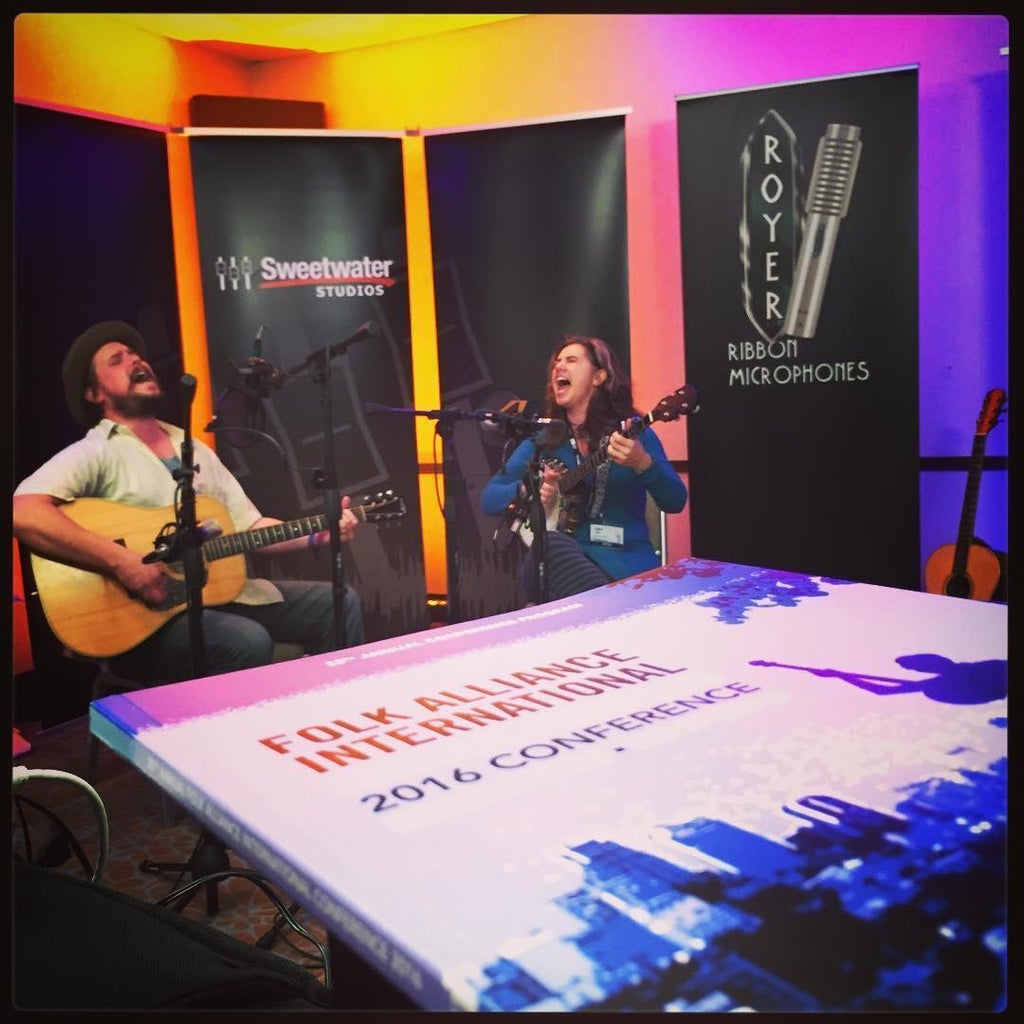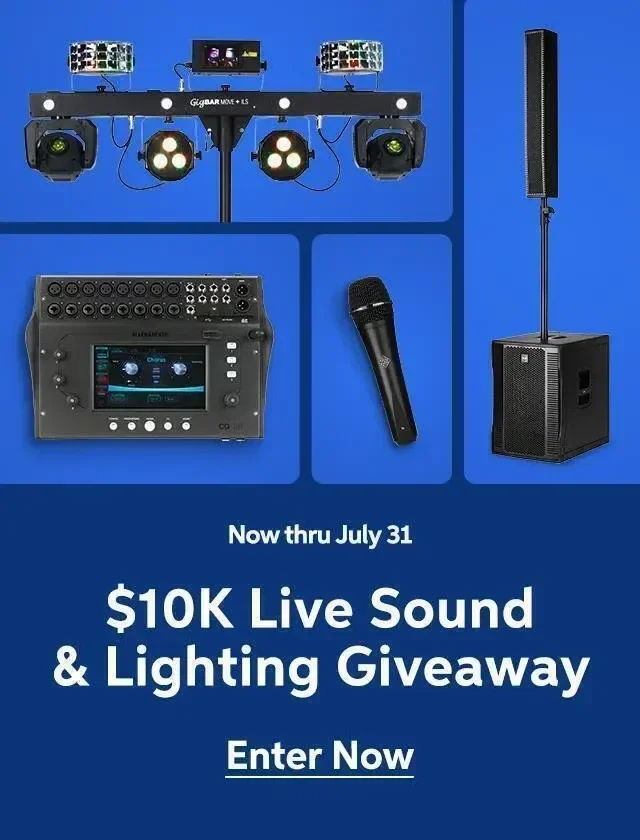
The 2017 Folk Alliance International Conference was held in Kansas City back in February — and since the Sweetwater Studios team spent the conference running a Pop-up Studio, we wanted to share with our more technically minded readers some of the insights we gained in the Folk Alliance Pop-up Studio, when we recorded more than 30 bands and more than 100 songs in three days.
The room
Our Pop-up Studio was set up in a room that was slightly larger than a typical hotel room, so the first thing we did was check out its acoustic signature. There was a dropped ceiling that seemed to have a good amount of insulation — at least, there weren’t a lot of reflections coming back from the ceiling. The room was carpeted, which minimized reflections coming back from the floor. The main source of anomalies — primarily reflections and bass buildup — were from the corners and side walls of the room, so we used Auralex ProMAX panels to help mitigate those issues.
The gear
Folk Alliance Gear We set up a Macbook Pro running Pro Tools HD, with 2 Universal Audio Apollo 8P channel interfaces. A pair of ATC SCM-25A speakers was used for playback, but since the recording engineer was in the room with the artists, the speakers were not turned on during recording. The musicians performed live in the room, without headphones. (The recording engineer would wear headphones to monitor the multitrack recordings, but none of the musicians wore headphones during the live sessions.)
The mics
The Pop-up Studio was cosponsored by Royer Labs and Mojave Audio, along with Auralex Acoustics and Sweetwater Studios, so all the microphones were made by Royer Labs and Mojave Audio. The mic list included pairs of Royer R-121s, R-122s, and SF-2s, plus an SF-24 stereo ribbon mic. We also had two Mojave MA-300 large-diaphragm tube mics, Mojave MA-301fet large-diaphragm FET mics, MA-100 small-diaphragm tube mics, MA-101 small-diaphragm condenser mics, and a Beta version of the MA-1000 mic. All the microphones were set up on stands and plugged in; given the short changeover times, all the mics needed to be ready to be put into use as needed.
Before we discuss the specifics of microphone choice, let’s talk about microphone pickup patterns. Since these were live full-band recordings, our goal was to try to isolate each instrument and vocal as much as possible under the circumstances. To make this work, we used the figure-8 setting on the Mojave microphones. The Royer microphones (actually most ribbon mics) also have a figure-8 pattern.
A microphone with a figure-8 pattern is sensitive to on-axis sounds (those coming from directly in front of and directly behind the mic) but is much less sensitive to sounds coming from off-axis (from the sides of the mic). When working with musicians who play instruments and sing, we position the vocal mic so that the singer’s mouth is on-axis, but the instrument is as close to directly off-axis as possible. This will minimize the amount of the instrument bleeding into the vocal mic. By using the same sort of placement on the instrument mic — with the guitar on-axis but the singer’s mouth as close to directly off-axis as possible — we can minimize the amount of vocal bleed that gets into the instrument’s mic and therefore onto the recorded track.
This is important, because anything done to one instrument’s track will affect other sounds bleeding into that track. For example, if vocals are bleeding into the guitar microphone, any processing done to the guitar track during the mixing process will affect the vocal sound as well. The goal is to have as little bleed as possible, to minimize this sort of issue.
When we recorded groups, the musicians were set up in more or less the manner of a live show: upright bass and drums/percussion (if present) in the back and singers and other instrumentalists in front.
One other important consideration, the Pop-up Studio is designed to capture live performances on the fly. There are no overdubs, no fixes, and in general, not a lot of time to experiment with microphone choice. So we set up multiple microphones on a source if we weren’t sure how our “standard” mic setup would sound on a particular instrument (or vocalist).
Room mics
In general, the stereo Royer SF-24 was placed front and center to use as the primary room microphone, with other mics set up as spot mics and blended in to help with clarity. This wasn’t true in every case — sometimes the individual microphones were the primaries, with the SF-24 simply adding a bit of ambience to the recording. Regardless, the SF-24 was in use with every act we recorded. Room mics are great — but you can’t use them if they aren’t set up. So it stayed ready and in place.
Live Recording at Folk Alliance
Vocals
The Mojave MA-300, a large-diaphragm tube condenser, was our first choice for lead vocals in the ensemble settings, with the (then unreleased) Mojave MA-1000 as an alternate. The Mojave MA-301fet was available for harmony vocals as well as use on other instruments. For artists whose voices were brighter or more sibilant, we could add a Royer R-122 as a secondary vocal mic. Since the engineer was monitoring the recordings on headphones rather than on our usual ATC studio monitors, the second mic could work as a safety. If we found that the condenser didn’t sound as expected with a given vocalist, the warmer sound of the ribbon mic would work great.
Guitars
Because we were recording live bands with the intention of mixing the tracks later, the multi-pattern capability of the Mojave MA-301fet placed near the bridge was our first choice for guitars. However, if a performer brought a particularly bright instrument, we could use a Royer R-122 to mitigate the brightness. With some guitarists, we added a Mojave MA-100 or MA-101fet small-diaphragm microphone around the 12th fret. In an effort to isolate the guitar from vocal bleed, we placed the Mojave a couple of inches in front of the guitar, pointing straight down at the floor. In this way, the guitar would still be picked up by this mic, but the singer’s mouth was above the back of the microphone, helping with isolation.
Violin/Fiddle
Because violins range so widely in tone, the mic choice was instrument dependent. With an SF-2 or a Mojave large-diaphragm mic, we could use the figure-8 pattern to minimize leakage from other instruments. But some violins simply sound better with a small-diaphragm cardioid microphone; in those cases, we used a Mojave MA-100, placed about eight inches above the instrument. This is a closer placement than usual in a studio setting, but it allowed us to use proximity to the primary source for isolation from more distant sources.
Mandolin
As with violin, mandolins vary widely in tone. For an earthier, woodier sound, a Royer R-122 was the answer; while for a more contemporary, sparkling tone, we would try the Mojave MA-101fet.
Upright bass
A Royer SF-2 or Royer R-122 was used on upright basses (as well as on a few bass amps brought in by electric bass players). We primarily tried to separate the upright bass from the other microphones by distance and by having the bassist set up behind the other instrumentalists. With this sort of setup, putting musicians’ bodies between their microphones and the bass helped with isolation, though we had to be careful when the musicians moved around.
Drums/Percussion
In keeping with the vibe of Folk Alliance, few full drum kits were used in the Pop-up Studio; cajons, snare drums, and the occasional kick drum were more common. For percussion, we used the Royer SF-2 or R-122s.
The takeaway
When recording this much music (remember, we recorded almost 100 songs from 30 bands over three days), there’s not a lot of time available for experimentation. So our general approach was to (a) set up a stereo mic — the Royer SF-24 — to capture the whole room, (b) set up combinations of spot microphones to give us alternates when one mic didn’t sound as expected, and (c) take full advantage of the figure-8 patterns of our microphones to minimize vocal and instrument bleed between tracks. We didn’t eliminate bleed, of course — and in a live situation, bleed can be a friend — but we did try to minimize it to make mixing easier.
In the weeks following Folk Alliance, Sweetwater Studios mixed one song from each participating artist or group and put a number of these recordings on the Pop-up Studio CD, which will be available to all registered attendees at the upcoming 2017 Folk Alliance International Conference. While organizing and running the Folk Alliance Pop-up Studio was a lot of work for all involved, it was also a lot of fun.
We at Sweetwater Studios are big supporters of artists and of conferences that bring artists together. We consider the Pop-up Studio a great way to give back to the artists.

